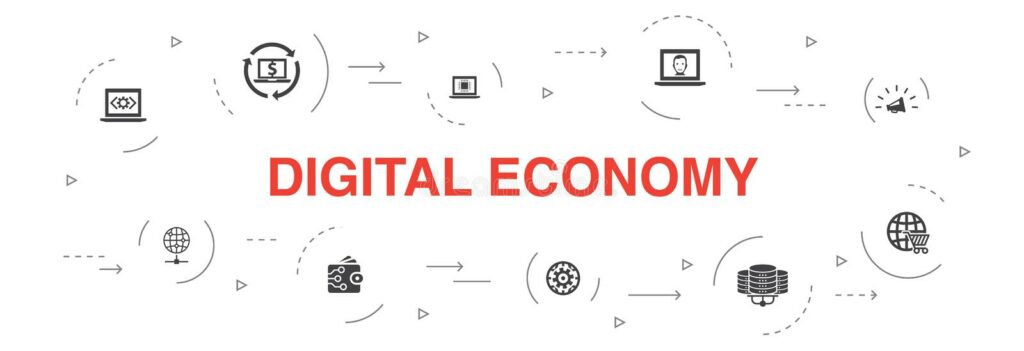The Digital Economy: What Is It? An outline of the cryptocurrency industry. The digital economy is transforming in ways that were once thought to be science fiction thanks to cryptocurrencies. More than just amazing technology, the crypto ecosystem is opening up the financial sector and all of its prospects to everyone in the world.
What Is the Digital Economy? An Overview of the Crypto Ecosystem
In this article, you can know about What Is the Digital Economy? An Overview of the Crypto Ecosystem here are the details below;
Exploring the most significant elements of the digital economy, from stablecoins to NFT gaming, is the greatest approach to comprehend how it is going to impact the world. Let’s begin with the cryptocurrency that spurred the current crypto revolution.
Value-storing mechanism in the digital economy
1. Store of value
Satoshi Nakamoto, who invented bitcoin, created it intentionally to replicate the qualities of gold as a store of value. Bitcoin is increasingly caught as a store of value due to its expanding acceptability as “digital gold” among both institutions and people. For long-term wealth preservation and inflation protection, sovereign wealth funds, pension funds, and numerous individuals are investing in bitcoin.
What does a store of value actually mean? A money, good, or asset that retains its worth or increases in value over time is referred to as a store of value. Notably, both in the crypto world and in conventional finance, bitcoin is regarded as a store of value.
2. Stablecoins
Cryptocurrencies known as stablecoins have a value anchored to a fiat currency, such as the US dollar. Stablecoins may be sent between multiple blockchains, which is what sets them apart from real-world dollars. For instance, you can transfer funds between the Ethereum and Solana networks using Tether (USDT) or USD Coin (USDC). Also check Product Development Lifecycle
Stablecoins are financial primitives that are essential to the development of DeFi and the broader digital economy. It is apparent that stablecoins are popular among cryptocurrency traders, utilized as both a safe haven asset and a unit of account.
Need to know more? Read our stablecoins article.
In the digital economy, smart contracts
3. Smart Contracts Platforms (Layer 1s)
Beyond bitcoin, smart contract platforms are the backbone of the crypto economy, enabling everything else, such as DeFi, NFTs, stablecoins, and web3. They offer the security, decentralization, and interoperability that enable several permissionless networks to communicate with one another and build upon one another. Layer 1s allow us to do everything else, while bitcoin allows us to send money across the internet.
common layer-1 protocols are:
Ethereum
Solana Cardano Polkadot Avalanche
Algorand Elrond Fantom
Protocol NEAR
Need to know more? Take a look at our post on smart contracts.
In the digital economy, DeFi
4. Decentralised Finance (DeFi)
Decentralized finance (DeFi) can perform the same functions as traditional finance, such as making loans and transferring assets, but DeFi does so without the use of a reliable middleman. By doing away with the conventional financial intermediaries, DeFi is far more effective and available to everyone in the world.
The top DeFi protocols are:
Protocol for Aave Compound Synthetix Uniswap
Need to know more? View our DeFi article.
In the digital economy, oracles
5. Oracles
In the crypto environment, oracles are essential since they link virtual networks to the physical one. An oracle, for instance, may gather data from the real world, such as market prices, weather information, or election outcomes. Then, in a DeFi transaction, smart contracts can utilize that data. Also check Leadership Coaching Services
Oracles are crucial because they gather information in a decentralized and safe manner. This means that if you want information that could be changed, you don’t have to rely on a single source. Institutions may feel secure doing DeFi protocol transactions worth hundreds of millions of dollars with reliable real-world data.
6. Web3
Web3 represents the fusion of the internet and cryptocurrency. In actuality, web3 is far more than just introducing a native internet currency. Web3 develops a decentralized platform with considerably better data security, no gatekeepers, and no single point of failure. In contrast to web2, when businesses controlled everything online, web3 will give users power over their own data and content.
The following are three of the most promising crypto infrastructure projects advancing web3:
7. NFT games
NFT games are entertaining for the cryptocurrency community. More importantly, they enhance the gaming experience. Users can own in-game objects and sell them for real money, as opposed to the game designer only owning everything. Additionally, with the expansion of virtual worlds, games like Decentraland are bringing the concept of the metaverse to life.
The future of the digital economy
Many of the aforementioned cryptocurrencies weren’t around when Cointree was established in 2013. The innovation has been amazing so far and is expected to get even better. These seven areas will become increasingly integrated and enhance the user experience as the digital economy develops. Although much has already been accomplished in the crypto sector, many still view it as in its infancy.
